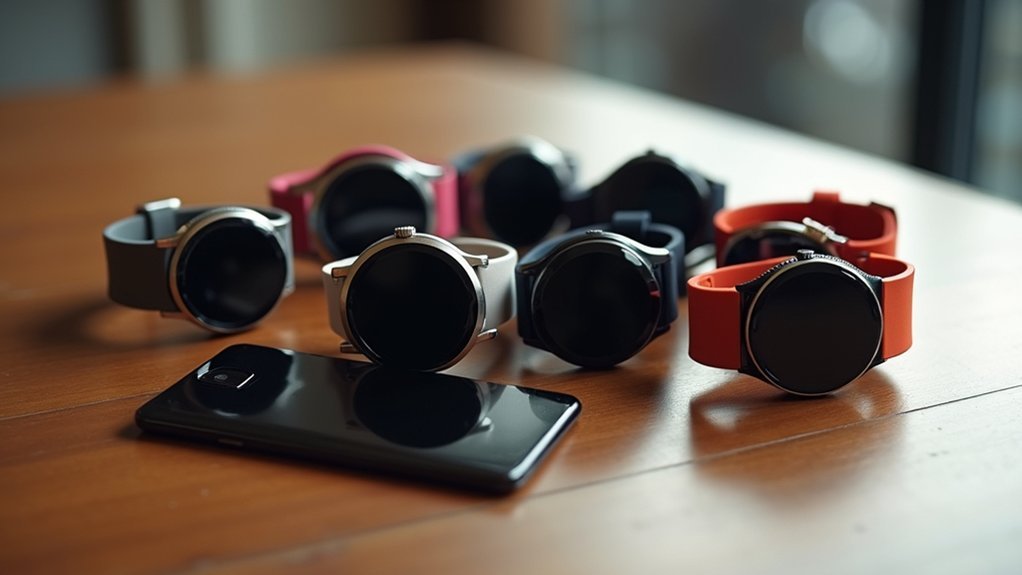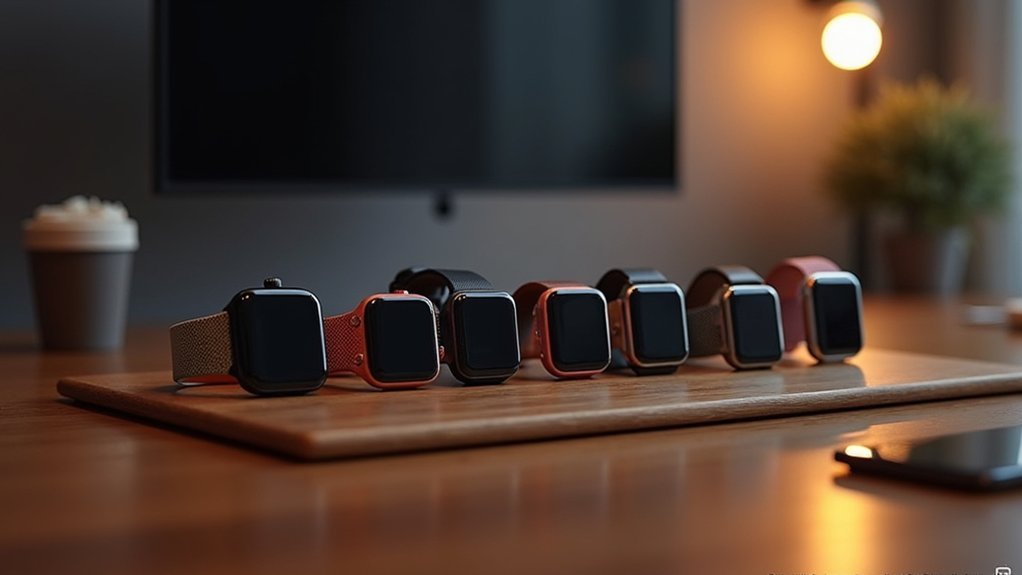You’ll get the smoothest workout experience with a 60Hz refresh rate smartwatch, which reduces motion blur during high-intensity activities like team sports. However, if you’re prioritizing battery life for extended training sessions, consider adaptive refresh rates that adjust between 1Hz and 60Hz based on your activity level. The Apple Watch Series 10’s 60Hz outperforms the Pixel Watch 3’s 1Hz for performance, though higher refresh rates can increase battery consumption by 20%. Explore below to discover which refresh rate matches your specific sport.
Understanding Refresh Rates and Display Performance in Sports Watches

When you’re tracking your performance during intense workouts, your sports watch’s refresh rate determines how smoothly and accurately real-time data appears on screen.
Measured in Hertz (Hz), refresh rate indicates how many times per second your display updates. Most smartwatches operate between 30-60 Hz, with 60 Hz providing ideal smoothness for rapid data changes like heart rate spikes or GPS tracking during movement.
Refresh rate, measured in Hertz, determines how frequently your smartwatch display updates per second for optimal data visibility.
Higher refresh rates minimize motion blur when you’re checking metrics mid-exercise, ensuring you won’t miss critical information during fast-paced activities.
However, you’ll face a trade-off: increased refresh rates consume more battery power. Many modern sports watches solve this by using adaptive refresh rates that automatically adjust based on your activity intensity, delivering smooth visuals when you need them while conserving energy during less demanding tasks. Premium models like the Garmin Enduro 3 feature AMOLED displays that provide exceptional clarity for viewing detailed metrics during extended outdoor activities.
Apple Watch Vs Pixel Watch: Comparing 1HZ and 60HZ Display Technologies
Two industry giants showcase dramatically different approaches to smartwatch display refresh rates, with Apple Watch and Pixel Watch representing opposite ends of the spectrum. You’ll notice the Pixel Watch 3’s always-on display refreshes every second at 1Hz, prioritizing battery conservation while maintaining visibility. In contrast, Apple Watch Series 10 can achieve 60Hz refresh rates during active use, delivering smoother scrolling and animations.
| Feature | Apple Watch Series 10 | Pixel Watch 3 |
|---|---|---|
| Refresh Rate | Up to 60Hz | 1Hz always-on |
| Display Brightness | 2,000 nits | 1,000 nits |
| Screen Size | 1.69″-1.9″ | 1.2″ |
| Battery Impact | Moderate | Significant with always-on |
| Responsiveness | High during use | Limited to 1-second intervals |
This difference affects your interaction experience, with Apple prioritizing performance and Pixel focusing on continuous visibility. The Pixel Watch 3’s 45mm model delivers extended battery performance lasting up to 48 hours, while the Apple Watch 10 maintains its traditional 18-hour battery life despite the higher refresh rate capabilities.
How Refresh Rate Impacts Battery Life During Extended Workouts

During extended workouts, your smartwatch’s refresh rate becomes a critical factor in determining whether you’ll finish your training session with power to spare or face a dead battery mid-exercise.
Higher refresh rates like 60Hz consume considerably more power, increasing consumption by up to 20% compared to lower rates. This can drastically shorten your battery life during marathons or long cycling sessions.
You’ll want to leverage power-saving modes that drop refresh rates to 1Hz during workouts. Many smartwatches automatically adjust refresh rates based on your activity type, while others let you manually configure these settings. The OnePlus Watch 2 offers VOOC charging technology that can fully charge your device in under an hour, providing quick recovery between training sessions.
The Garmin Enduro 3 exemplifies this balance, delivering over 30 days of battery life through efficient power management and strategic refresh rate optimization.
OLED Display Advantages for High-Intensity Activity Tracking
While traditional LCD displays struggle with visibility and power consumption during intense workouts, OLED technology transforms your smartwatch into an ideal fitness companion through superior contrast and energy efficiency.
You’ll experience vivid, high-contrast images that remain readable in direct sunlight, eliminating the squinting and glare that plague LCD screens during outdoor activities.
OLED’s individually lit pixels consume power only when illuminated, extending your battery life considerably during extended training sessions.
The always-on display maintains visibility without draining power, keeping your heart rate and workout stats constantly accessible.
You’ll benefit from faster response times that eliminate motion blur during rapid movements, while the thinner, lighter build reduces wrist fatigue. The self-illuminating properties eliminate the need for bulky LED backlights that add unnecessary weight to your wrist during long training sessions.
Sharp text and vibrant icons guarantee you can quickly scan notifications and fitness data without interrupting your workout flow.
Choosing the Right Refresh Rate for Your Specific Sport and Activity Level

Your sport and activity level should directly influence your smartwatch’s refresh rate selection, as different athletic pursuits demand varying levels of display responsiveness and real-time data access.
For running and cycling, you’ll find that accurate tracking features matter more than high refresh rates. Swimming requires water resistance over display smoothness. However, team sports benefit from faster refresh rates for quick-glance real-time data monitoring.
Consider these activity-based recommendations:
Match your smartwatch refresh rate to your training intensity and sport-specific demands for optimal performance tracking.
- High-intensity training: Balance refresh rate with battery life for sustained performance
- Casual fitness: Lower refresh rates sufficiently meet basic tracking needs
- Professional athletes: Prioritize advanced tracking features over refresh rate specifications
- Interval training: Choose responsive interfaces for quick workout adjustments
Your specific needs should guide this decision more than technical specifications alone. Athletes requiring consistent health monitoring might consider specialized devices with blood pressure measurement capabilities that offer additional health insights beyond standard fitness tracking.
Frequently Asked Questions
Can I Manually Adjust the Refresh Rate on My Smartwatch?
You typically can’t manually adjust your smartwatch’s refresh rate since manufacturers restrict these deep system settings for stability. Most smartwatches don’t offer this customization option through standard menus or third-party apps.
Do Higher Refresh Rates Cause More Eye Strain During Workouts?
Higher refresh rates don’t increase eye strain during workouts. You’ll actually experience less strain because smoother motion reduces blur. Brief workout glances differ from prolonged screen exposure that typically causes digital eye strain.
Which Smartwatch Brands Offer Variable Refresh Rate Technology?
You’ll find variable refresh rate technology primarily in Google Pixel Watch 3 and Apple Watch Series models using LTPO OLED displays. Samsung’s Galaxy Watch line also incorporates dynamic refresh rates for better power management.
Does Refresh Rate Affect the Accuracy of Heart Rate Monitoring?
Refresh rate doesn’t affect your heart rate monitoring accuracy. Your smartwatch’s PPG sensors and processing algorithms determine heart rate precision, not how smoothly the display updates information on screen.
Are There Smartwatches With Refresh Rates Higher Than 60HZ?
You won’t find mainstream smartwatches exceeding 60Hz refresh rates. Current models from Apple, Samsung, and Google max out at 60Hz due to battery constraints and limited benefits for typical smartwatch usage patterns.
In Summary
You’ll want to balance performance with battery life when choosing your smartwatch refresh rate. If you’re into high-intensity sports, you’ll benefit from 60Hz displays for smoother tracking, but expect shorter battery life. For endurance activities like marathon running, you’re better off with adaptive refresh rates or lower settings. Consider your primary activities and how long you’ll be away from a charger when making your decision.





Leave a Reply